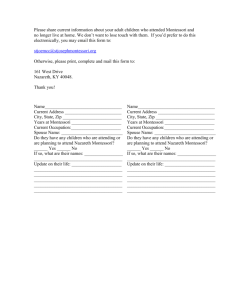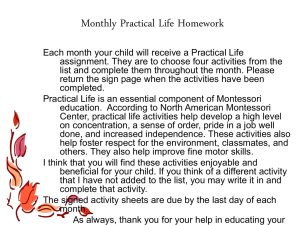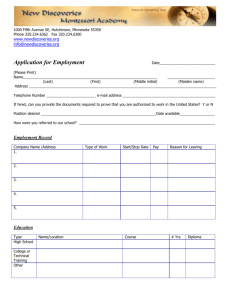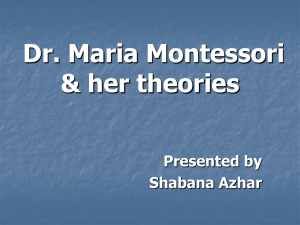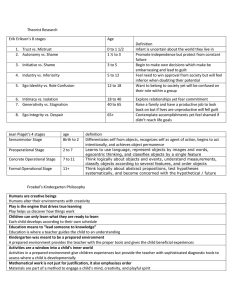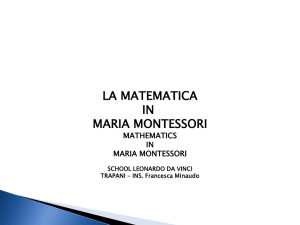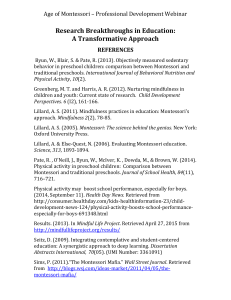How Important Are the Montessori Materials? ■ ▼ ●
advertisement
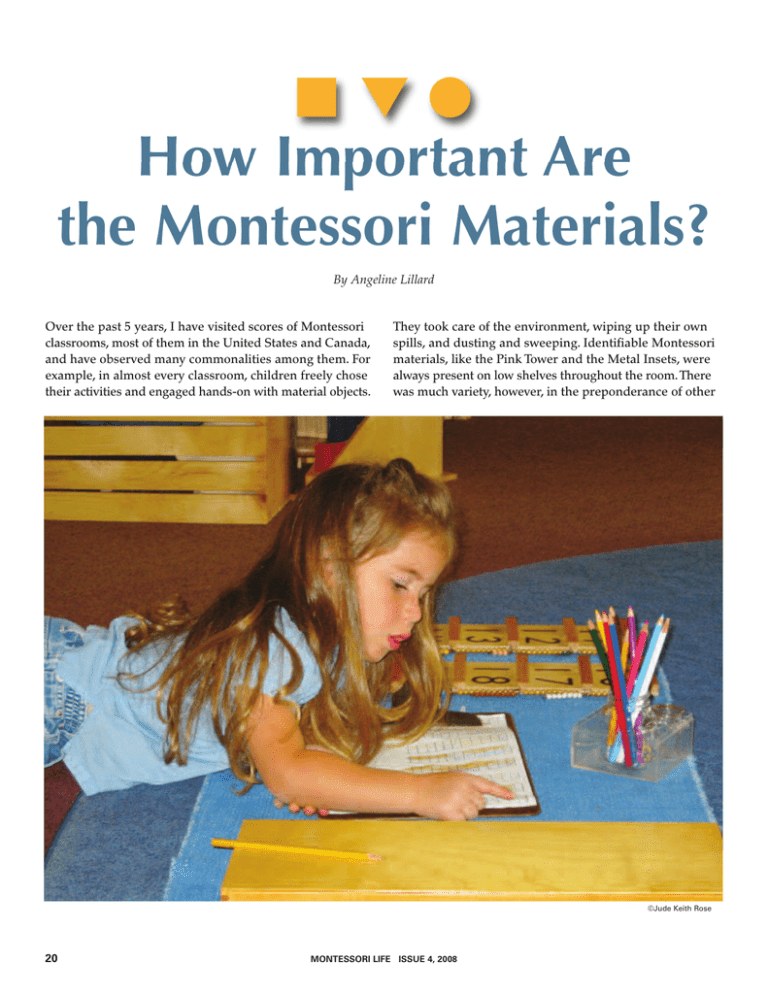
■▼● How Important Are the Montessori Materials? By Angeline Lillard Over the past 5 years, I have visited scores of Montessori classrooms, most of them in the United States and Canada, and have observed many commonalities among them. For example, in almost every classroom, children freely chose their activities and engaged hands-on with material objects. They took care of the environment, wiping up their own spills, and dusting and sweeping. Identifiable Montessori materials, like the Pink Tower and the Metal Insets, were always present on low shelves throughout the room. There was much variety, however, in the preponderance of other ©Jude Keith Rose 20 MONTESSORI LIFE ISSUE 4, 2008 materials available and in use. What might the presence and use of these alternative materials mean for the children and their education and development? We cannot know the answer short of controlled studies, but I think the issue warrants deep consideration. The Montessori materials have an interesting history. Many early ones were initially developed by Séguin for mentally retarded children and were adapted by Montessori in the early 1900s. From there, Montessori modified the originals and added to them. My impression, from her books and from conversations with people who have access to unpublished lectures and/or have spent time with people who worked directly with Montessori, is that tremendous thought and experimentation went into the development of these materials and their use.The Pink Tower, for example, is not merely a tower of blocks of increasing size, but instead is a carefully calculated instrument to educate the senses and the motor system, and to implicitly introduce the decimal system and the notion of cubing. Each block is 1 centimeter longer on all sides than the one that came before, and there are 10 such blocks, going from 1 cubic centimeter to 1,000. The increasing size is reflected not only visually but also haptically and barically: Each block is heavier by an exponentially increasing magnitude. I do not know why the tower is pink, rather than blue or green— perhaps it was simply the color the carpenter had on hand that day—but given the thought that we know went into so many aspects of the materials, even this detail might not have been mere convenience. The child uses the Pink Tower in a specific way: He carries each cube to a rug and then reassembles the tower from memory, from largest to smallest cube, carefully centering each subsequent cube over the preceding one. The material is treated with great care; the teacher is to intervene when materials are handled roughly. When finished, the tower is admired, then carefully dissembled and returned to its original location. (In the early days, it was knocked down, but this was later considered a rough use of the material and was discontinued.) Montessori watched children in the classroom and thought about their developmental needs; she developed materials that she thought would suit those needs; and she then watched the children with the materials, and revised and refined them until she thought she had a material that would meet one or more specific needs. So, for example, there are 10 Metal Insets, not 3 or 15, because Montessori found that different numbers did not entice the child’s interest in the same way. To get the children to engage and stay engaged with the Metal Insets—and thereby develop concentration, learn to hold and handle a pencil, learn the names of the shapes, and experiment with color and design— she found they needed 10 (Montessori 1914/1965, p. 114). The Sandpaper Letters are cursive because Montessori believed it easier for beginning writers to keep the pencil on the paper, flowing from one letter to the next, rather than stopping and starting again for each new letter. The choice of materials was very intentional, as is clear from reading the descriptions in The Montessori Method and Montessori’s lectures about materials, and from discussions I have had with people who worked closely with her or others in her immediate circles. Montessori watched children in the classroom and thought about their developmental needs; she developed materials that she thought would suit those needs; and she then watched the children with the materials, and revised and refined them until she thought she had a material that would meet one or more specific needs. Not only does each material have many purposes, but also there is little redundancy across the materials, and redundancy is highly intentional where it exists: For example, there are many small knobs to assist development of the pincer grip because it is considered so important. But given a set of Metal Insets for holding and handling a pencil and following a specific line, there was no perceived need for stencils or other objects to fulfill that purpose. With Red Rods to exercise working memory (the amount of information one can hold in his mind at once), by having the child walk across the room to retrieve from a pile the rod just longer or shorter than the one just placed, one did not need the game of Memory in the classroom. In addition, each material was developed in the context of all the other materials. The Solid Cylinders (or Solid Insets) set in motion thinking about changes in dimension, leading to the Pink Tower with three changing dimensions, then the Brown Stair with two, then the Red Rods with just one. Montessori discussed the particular difficulty of the last material, as the child is learning to perceive a difference in a single dimension: “Sometimes it happens that a child working with the long rods makes the most glaring mistakes” (Montessori, 1914/1965, p. 76). Perceiving this single dimension difference would be mastered around age 4, when children would be given the extension exercise of assembling the materials individually across the room from where they were stored (Montessori 1912/1965, p. 194). The Red Rods would lead into math in the context of what came before (Pink Tower and Brown Stair) and MONTESSORI LIFE ISSUE 4, 2008 21 after (Red and Blue Rods). Mastering the pencil with the Metal Insets set the child up for writing in the context of the child also having learned how to form the letters and knowing what they represent. This knowledge was conveyed through use of the Sandpaper Letters. The Metal Insets, without that other supporting material, would not lead to writing. And so on. By design, the materials have this complex interweaving nature, so one material feeds into or plays off of another. . . . the original set of materials, as it had evolved by Montessori’s death in 1952, comprised a specific set of materials for each classroom level. . . Dr. Montessori developed a specific set of materials to work together not only within the classroom, but also across classroom levels.The set within each classroom was intended to be about the right size set for a child to master in about 3 years in the classroom (or 6 years in Elementary for the full program). And the materials the child would see in the next classroom not only referred to the materials in the earlier classroom (sometimes they were the same materials, used in a more complex way), but also required the understanding conferred by that earlier material. In sum, then, the original set of materials, as it had evolved by Montessori’s death in 1952, comprised a specific set of materials for each classroom level, carefully designed to confer specific understandings through repeated use and in the context of other materials, selected to avoid most redundancies, and quantified to allow mastery in about 3 years in a classroom. As Montessori has evolved, we might say two approaches have been taken. One has been to keep very much to Dr. Montessori’s sets of materials (at each classroom level), with few changes; for lack of a better word, I will call this the traditional approach. The second, which I will call the modified Montessori approach, has been to adopt modifications in a democratic fashion, with each teacher trainer and teacher making decisions about new materials to add to the set (or, at times, what to take out). Some of the added materials are readily available commercially and are not unique to Montessori (e.g., puzzles); others are presented and sold at Montessori teacher conferences and/or in Montessori catalogs. The result, after some 50 years, is a wealth of alternative materials in many Montessori classrooms, materials in whose creation Dr. Montessori did not have a hand. What are some of these materials, and what might be 22 the consequences of their inclusion in the classroom? One common category of modified materials I see is puzzles, games, and crafts projects. Children might be on the floor with a large puzzle of different animals from all over the world, or of planets of the solar system, or just a fantasy puzzle or a tangram. Or they might be playing the game of Memory or Chess, or making valentines or collages from magazines. Children often are very engaged in such activities, and in classrooms that offer a lot of them, I have seen 90 percent of the children involved in such activities while the Montessori materials gather dust in the corners. Because of the popularity of such materials for the children, a teacher trying to “follow the child” might well decide to add more. Why do some children prefer these materials, and what is their impact? For the why, I am not sure. Perhaps it is because such materials are more familiar; perhaps it is because children have seen their peers using them. Something I also wonder is whether the teachers are not conveying to the children the sense that the Montessori materials are very, very special. In classrooms where children use the Montessori materials, teachers appear to present them as if they were presenting something magical, and the teachers also take great pains to encourage the children to strive for perfection in their every movement—not only in how they handle these special objects, but also in how they walk across the room, push in a chair, and so on. The level of attention to detail—keeping the pencils sharp, keeping objects straight on the shelves—that teachers show seems to be assimilated by the children, inspiring an attitude toward the materials that goes along with their use. What are some of the effects on the children of using other materials instead of Montessori materials? Consider the puzzle. Puzzles engage the hand, but do so in a very different way than many of the other activities Montessori designed. They teach spatial relations, which is redundant with traditional Montessori materials, like the Puzzle Maps, which also teach geography. The child learns to trace the Puzzle Map pieces first with her finger and then with a pencil as she recreates the maps on paper. Movement is aligned with cognition. And the child learns a fixed set of relations: France is always by Spain. This is not the case with many other puzzles; for example, in a puzzle of animals, each animal’s appearance next to another animal might be arbitrary (giraffes next to polar bears, for example). Children do not appear to be learning the animals by learning their shapes, because I never see them trace the outlines of these puzzle pieces—and besides, unlike countries, animals change shape when they move. So what children are learning from these other puzzles is more limited. And, by using their time on those puzzles, children MONTESSORI LIFE ISSUE 4, 2008 ©Jude Keith Rose are not learning the geography they could be building on later as they advance to other materials. Another category of modification to consider is materials that those taking a more traditional approach would place at different levels, in the 0–3 or the Elementary classroom: colorful wooden pegs in a board with holes or a model of the solar system. Clearly, materials from a higher or lower level should be allowed for children when needed. Sometimes I think teachers include materials from other levels not to meet the needs of an individual child but to enhance the traditional set of materials. There are also times when materials that do belong in the classroom are being used by children who are beyond the developmental level for which the material was intended: for example, a 5-year-old just learning Sandpaper Letters. Sometimes there are good reasons for this, but in some classrooms with lots of modified materials, my sense is that the children were busy doing puzzles at 3 and 4, so the teacher must try to get some letters in before the child moves to the next level. But if feeling sandpaper is more engaging at 3 than at 5 (is it?), the teacher has created a challenge to interest, a problem which goes back to the presence of puzzles in the classroom earlier but is coming out in ageinappropriate targeting of materials. Sometimes changes can have consequences far down the line, consequences that might not be anticipated early on. Yet another category of modification is alternative Practical Life materials. Practical Life is, of course, not set in stone: Teachers are supposed to design their own Practical Life activities. But what I see very commonly is that the MONTESSORI LIFE ISSUE 4, 2008 23 Audubon Charter School importance of the “practical” part of Practical Life has been forgotten. These activities were intended by Dr. Montessori to have a practical purpose in care of the self, community, and environment. In the first Children’s House, children were taught to bathe themselves, not a doll; they then went around the classroom and really cleaned what needed cleaning. As she wrote in Dr. Montessori’s Own Handbook, whereas some children have a toy kitchen in which to pretend to cook (and so on), “This method seeks to give all this to the child in reality— making him an actor in a living scene” (Montessori, 1914/1965, p. 47). Still today, the child washes a table in the classroom because the tables do need washing. The child polishes his or her own leather shoes, so they will look shiny and nice. The child arranges lovely flowers and sets them around the room for beautification, waters real plants for their sustenance, irons napkins, makes muffins for snack, and so on. Real, true purpose is a hallmark of Practical Life. The main exceptions to this are the Dressing Frames: We don’t normally button up clothes in wooden frames. The reason for making this exception was wellconsidered: It is difficult for small hands to learn to button, zip, and tie. It is often hard to reach and manipulate these objects on one’s own clothes, and another person might not willingly stand as a model for the time it could 24 take a beginner to accomplish the task—even if the buttons and zippers were easy enough to reach and work. The Dressing Frames give children a place to analyze and practice the movements needed for actual work with clothes. But very few activities require special apparati like the Dressing Frames. Modified Practical Life activities are ones that do not reflect what we actually do: polishing a model shoe instead of the shoe one wears, lifting cotton balls with tongs and moving them from one jar to another (one might use tongs with ice or olives, but not cotton balls!), using a dropper to move liquids from one vessel to another for no purpose other than the movement, hammering plastic nails into clay—why? We do not know whether children of 3 to 6 years of age detect the difference between polishing their own shoes and a model shoe, or have a different sense about grating soap simply to practice grating versus grating cheese for a pizza they will make. But one would expect they do: children begin to form action plans at a very early age, and practical life without a further purpose is like an isolated part of an action plan, like a factory worker who is only allowed to put in one screw over and over and never see the whole. The question arises as to whether children in classrooms where Practical Life activities serve a practical purpose engage in their work with more heart than in classrooms where they reflect these modifications? Finally, there is the category of using materials for purposes for which they were not intended. For example, I have seen children combine the Brown Stair with the Knobless Cylinder to make towers, take animals from Language Boxes, ignoring the language cards, and make animals converse and play, and use the Red Rods as guns. Is this kind of play with materials okay or not? As I discussed in Chapter 5 of Montessori: The Science Behind the Genius, there is research suggesting it would not be: that children who used the animals as toys, for example, would have more trouble making the symbolic link to their representation of a real animal as denoted by the language card. Seeing elements of the Brown Stair as a pillar of a building would cloud the child’s capacity to see it as one of a series of similar objects of gradually changing dimension. Related to this are modifications that involve using the materials in nonstandard ways, for example, having the Long Bead Chains go in a circle. What does it do to the child’s understanding of skip counting when the chain is laid out in a circle rather than in a straight line? Does it change the cognitive experience? I would suspect so, based on research in cognitive psychology showing how our spatial metaphors map to our understandings. For example, if I say, “Let’s move the meeting back a few days,” whether you take this to mean “farther into the MONTESSORI LIFE ISSUE 4, 2008 future” or “nearer to the present time” will depend on whether you have been primed to think about yourself moving (Boroditsky, 2000). Representations of space profoundly influence thought, and it might not be the same exercise to put a bead chain in a circle as to extend it in space. Likewise, to make the Pink Tower from a picture of a Pink Tower might not be the same as remembering what the Pink Tower should look like—it surely is exercising different skills. When one puts a new material in the classroom, has one given it the same degree of consideration that Montessori did in coming up with the traditional set? What do all these modifications mean for Montessori? Research is clearly needed, but the issues deserve discussion now. When one puts a new material in the classroom, has one given it the same degree of consideration that Montessori did in coming up with the traditional set? For commercially available materials, did the designer give them the same degree of consideration as Dr. Montessori gave the materials that were in her core set at the end of her life? How does the new material fit with what is already in the classroom? What other material should the child use less often, now that there is an additional material to use? How might the skills learned with the new material overlap with those developed from using other materials? How do these new materials fit into the sequences laid out by Montessori? Another issue to consider is that certain of the modi- fied materials obscure what is unique about a Montessori classroom, since most preschool classrooms offer puzzles, games, and crafts. If children mainly engage with these sorts of activities rather than the Montessori materials, then what makes Montessori, well, Montessori? Does it all come down to the free choice (which many preschools have to some degree) and the presence of the Montessori materials, even if they are not used? To what degree does a Montessori education come from repeated use of the materials, and to what degree is it only about a teacher’s attitude toward and treatment of the children? References Boroditsky, L. (2000). Metaphoric structuring: Understanding time through spatial metaphors. Cognition, 75(1), 1–28. Montessori, M. (1912/1965). The Montessori method. New York: Schocken. Montessori, M. (1914/1965). Dr. Montessori’s own handbook. New York: Schocken. ANGELINE LILLARD is a professor of psychology at the University of Virginia. She received a PhD from Stanford University in 1991; in 1999 she was the recipient of the American Psychology Association’s Boyd McCandless Award for distinguished early career contribution to Developmental Psychology. She attended Montessori as a child, was taught by Hilda Rothschild, and has been steeped in it ever since through her family. In the 1980s, she took the Assistants to Infancy Training in Houston and Rome. Her book Montessori: The Science Behind the Genius was awarded the Cognitive Development Society’s 2006 Book Award. She spoke at Montessori Centenary conferences in New York, San Francisco, Rome, Stockholm, and London. Contact her at lillard@virginia.edu. MONTESSORI LIFE ISSUE 4, 2008 25
